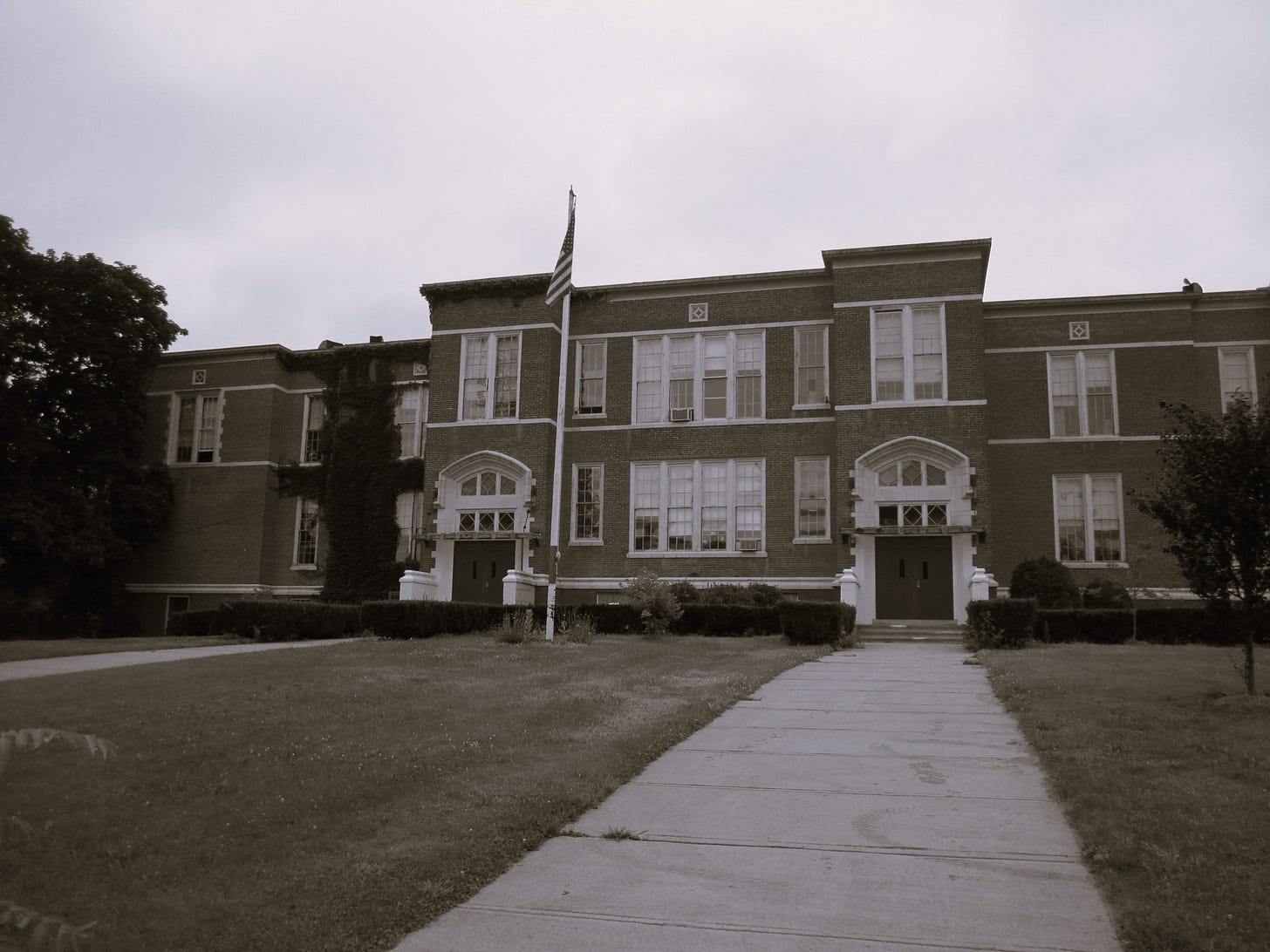Fourth Grade (Part I)
Personal Memoir
If I try hard enough, I can imagine Miss Norton standing in front of the blackboard in Room 16, up on the second floor of Tatnuck Elementary. Although I didn’t plan on becoming a teacher, it’s where my life led me. My second career was teaching, a profession that spanned over twenty years, in various roles and at different sites throughout my local school district. People in the education trade always ask, “Who was your favorite teacher?” or “Why did you become one?” The questions grow old fast, especially at the beginning of a new school year during pre-service days. My answer is noncommittal at best. The majority of my primary and secondary school teachers were your run-of-the-mill public servants; they strove to enlighten me while I mastered the skills they imparted. Some of the more effective ones linger in the dark recesses of my brain, clinging to dusty cobwebs for the most part, because they crossed my path several times, like Mr. Rawson who taught me French in junior high. I occupied a seat in his classroom for three years, conjugating verbs and confusing celui-là and celui-ci, over and over again.
Miss Joyce, my ninth grade English teacher and Ballroom Dance instructor, was memorable because she stuck around forever. As a member of the last graduating class of Chandler Junior High School, I bid her a fond farewell in June 1983. We read a remarkable selection of literature in her classroom that year, including The Odyssey and Romeo & Juliet. She entertained us and made the learning fun. She also sponsored the annual Ballroom Dance, a long-held tradition for the ninth-graders, but in order to attend, we were all required to participate in her after-school club where she taught the basic moves to dances like the Waltz or the Foxtrot. As the night of the Ball grew closer, her daily nagging to attend dance club left me exhausted at the mere mention of the words “ballroom dancing.” I thought I had escaped Miss Joyce’s clutches when I moved onto Doherty High School, only to find myself in her homeroom class for the next three years where she continued to pester us to attend her after-school dance club.
Among all the teachers I’ve had over the years, Miss Norton stands out as being truly remarkable. She left an indelible mark on my psyche, although I hardly remember what she looked like, almost fifty years later. By the time I crossed over the threshold of her fourth-grade classroom, she was forty-seven—a consummate teacher who had dedicated her life to furthering the education of her students. She taught with the perfect balance of discipline and compassion, and I was terrified of disappointing her.
Miss Norton worked for many years at Tatnuck Elementary, a school named after the Nipmuc word for the area—Tatnie, which means wilderness. The school continues to serve the students of Worcester’s western quadrant, and today is known as the Tatnuck Magnet School. The original building was constructed in 1909, an imposing two-story brick structure that looked down upon Pleasant Street across a wide green lawn—the oldest school I ever attended, at least until I reached college. Tatnuck’s majesty impressed me since the day I arrived as a shy and sorrowful second-grader. Its formidable façade featured not one, but two front entrances, each one a twin of the other, which featured a short span of steps with a broad landing that was covered by a patinated copper and glass awning, and edged with solid granite balustrades. Six transom windows topped the heavy metal double doors; their glass panes decorated with simple geometric muntins. A white granite arch united all the elements together into a portal worthy of its mission—the education of young and impressionable minds.
Dozens of towering white casement windows allowed the fickle New England sunlight to illuminate the interior spaces where broad hallways and a myriad of staircases connected the offices and classrooms. Room 16 faced the playground behind the school. When seated at my desk, I could only see the wispy clouds moving across a bright blue sky or the treetops swaying in the wind. A row of cast iron radiators below the windows creaked and groaned throughout the winter months, pouring out heat in a vain attempt to ward off the frost forming on the glass. Months later, when the heat and humidity rose, we wrestled open the swollen window sashes in hopes of catching an elusive breeze.
We sat at wooden desks, arranged into neat rows as the custom of the day demanded. The desk lids lifted up, making it harder to play with the contents inside, a hindrance for those inclined to fiddle with trinkets or other contraband. Some of the older desks even possessed a circular slot for an inkwell. An ancient chalkboard covered one wall, while a multitude of cupboards graced another. Backpacks, coats, winter boots, and the occasional musical instrument were stuffed into compartments or hung from dozens of hooks. The oak floorboards, though highly polished, were chipped and warped from age. The sound of every scrape or footstep echoed off the tall ceilings. Alphabet cards, cursive writing examples, and educational posters, including Uncle Sam’s latest one promoting the four food groups, decorated the walls. Miss Norton advocated a balanced diet and good nutrition.
Our fourth-grade days were filled with the standard curriculum—reading, math, science, social studies, cursive writing, poetry, and so on. We studied our state’s history, learning about the Pilgrims and the American Revolution. In the school library, I found a book about Deborah Sampson. She disguised herself as a man to fight in the Revolution. I fell in love with her courage and temerity. A few years later, the Commonwealth of Massachusetts proclaimed her to be the official state heroine—a proclamation of which I greatly approve. We memorized the names of the state’s fourteen counties and then used colored pencils to illuminate maps that were later displayed on the board outside our classroom. We wrote haikus in cursive, decorated the final copies, mounted them on colored paper, and hung them next to the maps in the hallway.
Every month Miss Norton assigned a poem and gave us the month to memorize it. Each morning, after the pledge and other daily tasks, two or three students volunteered to recite the poem. Some months I learned the poem faster than others, but more often than not, I waited until the last week for my dreaded recitation. Anxiety crippled me as I stared at the faces of my classmates who judged me with their smirks, crooked grins, and inappropriate giggles. My stomach clenched while tears threatened to fall. And yet, somehow, I managed to croak out the lines before fleeing back to my desk.
Miss Norton loved books and she encouraged her students to read more. My favorite incentive was her book cabinet. For every novel we read independently, Miss Norton wanted us to write a short summary. After we submitted ten, we earned a trip to a shallow cupboard in the hallway where she kept a stash of brand new Scholastic books. Two of my prized possessions are books that I earned that year—Caddie Woodlawn and Heidi—with Miss Norton’s felicitations written inside the front covers.
I learned to read early, no doubt in part to PBS and the early days of Sesame Street, but mostly because my college-educated parents filled our house with books. Any good teacher will tell you to read early and often to your children. My parents were happy to oblige. I fell in love with books and found happiness curled up in a corner with a book in hand. My avid literary habits elevated me to the top of the reading scale throughout elementary school. In her classroom, Miss Norton adhered to the practice of reading circles, choosing books for small groups of students based on their reading level. My group read several novels together, including The Lion, the Witch, & the Wardrobe, Caddie Woodlawn, and A Wrinkle in Time. For A Wrinkle in Time, Miss Norton assigned each student a chapter to read and summarize. Afterwards, we presented our synopsis to the group. I was allotted chapter nine, titled “IT,” when Meg battles the evil IT—the large disembodied brain that controls the planet Camazotz—to free her brother Charles Wallace from IT’s influence. To this day, I am not sure if I was more terrified of IT or my oral presentation. The combination of books Miss Norton chose for us influenced my life-long love of fantasy & science fiction, and I will be forever grateful to her for that.
I gravitated towards fourth grade when I became a teacher because of the fond memories I hold from Miss Norton’s class. I learned to teach in front of three different fourth grade classes during my year-long teaching practicum. In the final years of my educational career, I found a fantastic fourth grade team that welcomed me as one of their own. Rosemary Norton died five years ago, in March 2020, as the pandemic swept across the country, and the lockdowns began. Her extended family and a devoted circle of friends grieved her passing. Memories of her will live on through them and the hundreds of children she guided over the decades, including me.
To be continued…

To read more about Miss Norton, here is her 2020 obituary.



Love this. Your elementary school sounded like mine, all the way down to the hinged-top desks with ink wells.